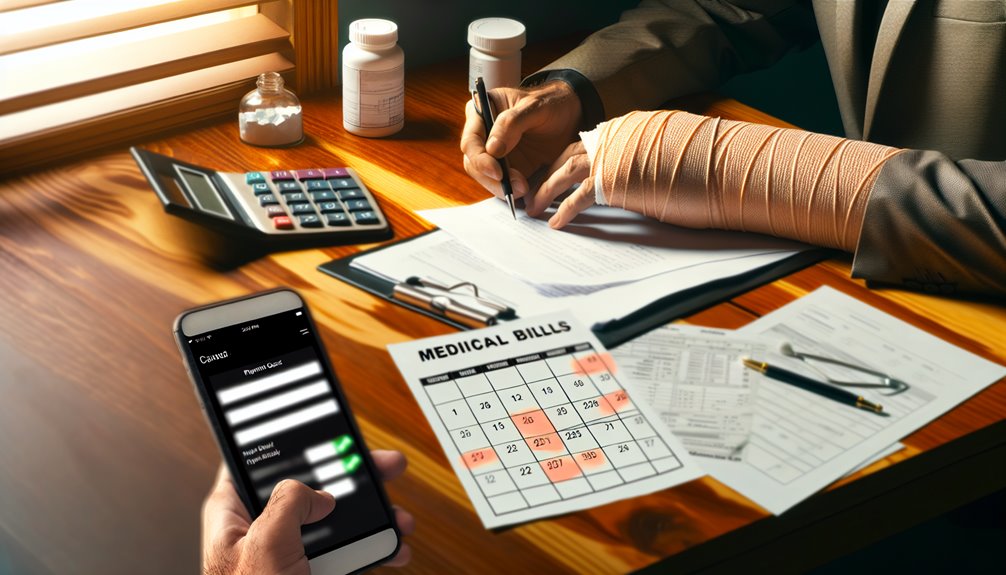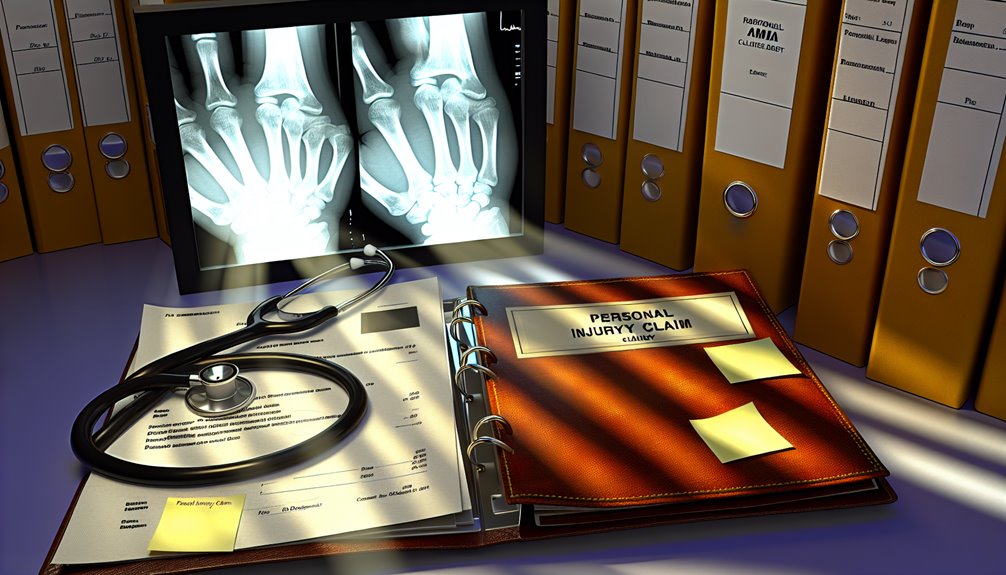A personal injury claim allows you to seek compensation when someone else’s negligence causes you physical, emotional, or financial harm. You’ll need to gather strong evidence, including medical records, witness statements, photos, and documentation of lost wages to support your case. Strict legal deadlines apply, so you should act quickly to preserve your rights. While insurance companies may pressure you to settle quickly, it’s important to understand your claim’s full value before accepting any offers. Working with an experienced personal injury attorney can help protect your interests and maximize your potential compensation. The process involves many essential steps that can greatly impact your outcome.
What Qualifies as Personal Injury

Personal injury encompasses any physical, emotional, or psychological harm caused by another party’s negligence, recklessness, or intentional actions.
You’ll find that personal injury claims often arise from various scenarios, including car accidents, slip and falls, medical malpractice, workplace accidents, and defective product incidents.
Physical harm can range from minor injuries like sprains and bruises to severe trauma such as spinal cord injuries, brain damage, or permanent disabilities.
These injuries might require extensive medical treatment, rehabilitation, or long-term care. Your claim may also cover the resulting financial losses, including medical bills, lost wages, and diminished earning capacity.
Beyond physical harm, personal injury claims recognize emotional distress and psychological trauma.
You might experience anxiety, depression, PTSD, or other mental health issues following an accident or incident. The law acknowledges these non-physical damages as legitimate components of your claim.
To qualify for a personal injury case, you’ll need to demonstrate that another party’s actions directly caused your injuries and that you’ve suffered measurable damages as a result.
Gathering Essential Evidence
Once you’ve determined that you have a valid personal injury claim, building a strong case requires thorough documentation and evidence.
Start by gathering medical records, including emergency room visits, doctor’s appointments, prescribed medications, and rehabilitation treatments. These documents establish the extent of your injuries and connect them directly to the incident.
Collect witness statements from anyone who saw the accident or its immediate aftermath. Their accounts can provide vital third-party perspectives that support your version of events.
Take detailed photographs of your injuries, property damage, and the accident scene, if possible. Photographic evidence creates a visual record that’s difficult to dispute and can demonstrate the severity of the incident.
Keep all receipts related to your injury, including medical bills, transportation costs to appointments, and any necessary modifications to your home or vehicle.
Document lost wages by saving pay stubs and obtaining a statement from your employer.
Create a daily journal detailing your pain levels, limitations, and how the injury affects your daily activities. This contemporaneous record strengthens your claim by showing the injury’s ongoing impact on your life.
Meeting Legal Deadlines

To protect your right to compensation, you must understand and comply with your state’s statute of limitations – the legal time limit for filing a personal injury claim. Missing vital legal deadlines can permanently bar you from pursuing compensation, regardless of your case’s merit. Your claim timeline typically begins on the date of your injury, though some exceptions exist for cases where injuries aren’t immediately apparent.
Beyond the statute of limitations, you’ll need to meet several other time-sensitive requirements throughout your case:
- Insurance claim notification deadlines, which often require prompt reporting within days of the incident
- Medical treatment documentation deadlines, guaranteeing timely records of your injuries and treatment
- Court filing deadlines for various legal documents and motions
- Expert witness designation deadlines, if your case requires professional testimony
- Settlement negotiation timeframes, which may be influenced by court schedules
Don’t risk losing your right to compensation by missing critical deadlines. It’s advisable to consult with a personal injury attorney early in the process, as they’ll help manage your claim timeline and guarantee compliance with all legal requirements.
Many deadlines are strict and unforgiving, making prompt action essential.
Working With Insurance Companies
While meeting legal deadlines keeps your claim on track, maneuvering insurance company interactions presents its own set of challenges. You’ll need to understand that insurance companies aim to minimize payouts, often using various insurance tactics to achieve this goal. They might request recorded statements, pressure you to settle quickly, or dispute the severity of your injuries.
During claim negotiation, it’s essential to document all communications with the insurance company and avoid providing more information than necessary. Don’t sign any documents or accept settlement offers without first consulting your attorney. Remember that your first interaction with the insurance adjuster can greatly impact your claim’s outcome.
You should direct all insurance company inquiries to your attorney once you’ve secured legal representation. Your lawyer can protect you from common pitfalls, such as accidentally admitting fault or understating your injuries.
They’ll also handle the complex negotiation process, knowing when to push back against lowball offers and how to calculate the true value of your claim, including future medical expenses and long-term impacts on your quality of life.
Calculating Your Damages

Calculating damages in a personal injury claim requires careful assessment of both economic and non-economic losses. You’ll need to document every expense and impact related to your injury to guarantee you receive fair compensation. The economic impact includes immediate medical costs, ongoing treatment expenses, lost wages, and potential future earnings losses.
When evaluating non-economic damages, you’ll need to take into account factors like emotional distress, pain and suffering, and loss of quality of life. These elements are harder to quantify but equally important in your claim’s overall value.
Key components to document for damage calculations:
- Medical bills, including emergency care, surgeries, medications, and rehabilitation costs
- Lost income documentation, including pay stubs, tax returns, and employment records
- Property damage receipts and repair estimates
- Expert testimony regarding future medical needs and earning capacity
- Records of psychological treatment and emotional impact statements
You’ll want to maintain detailed records of all expenses and keep a daily journal documenting your recovery progress. This information will strengthen your claim and help your attorney negotiate a settlement that accurately reflects your total losses.
Common Types of Claims
Personal injury claims encompass several distinct categories that you’ll need to contemplate before pursuing legal action.
Car accident claims remain the most common type, involving collisions between vehicles, pedestrians, or cyclists.
Slip and fall claims typically occur on commercial or residential properties where unsafe conditions lead to injuries.
Workplace injury claims address accidents that happen on the job, while medical malpractice claims target healthcare providers who’ve delivered substandard care.
You might encounter product liability claims when defective items cause harm, or dog bite claims if you’re attacked by someone’s pet.
Emotional distress claims can stand alone or accompany other injury types, addressing psychological trauma from an incident.
Construction accident claims often involve complex liability issues between contractors, property owners, and workers.
In cases where negligence leads to death, you’ll need to contemplate wrongful death claims, which family members can pursue.
Nursing home abuse claims protect elderly residents from physical, emotional, or financial exploitation.
Each claim type has specific legal requirements, evidence standards, and statutory deadlines that you’ll need to navigate with proper legal guidance.
Choosing the Right Attorney

Steering through the various types of personal injury claims demands experienced legal representation to maximize your chances of success. When selecting your attorney, you’ll need to carefully evaluate their track record, reputation, and ability to handle your specific type of case. Your chosen legal representative should possess both the attorney qualifications and resources necessary to build a strong case.
The right attorney won’t just have impressive credentials – they’ll also prioritize client communication and keep you informed throughout the legal process. You should feel comfortable asking questions and confident that your attorney understands your goals.
- Look for an attorney with specific experience handling cases similar to yours
- Check their success rate and average settlement amounts
- Verify their standing with the state bar association and review client testimonials
- Confirm they’ve adequate resources to fund your case through trial if necessary
- Evaluate their communication style and responsiveness during initial consultations
Don’t rush your decision. Schedule consultations with multiple attorneys to compare their approaches and expertise.
Settlement Vs Trial Considerations
When deciding between settlement and trial for your personal injury case, you’ll need to weigh several critical factors, including time investment and financial costs.
You should understand that settlements typically offer faster resolution and predictable outcomes, while trials can extend for months or years with uncertain results.
Your level of control differs considerably between the two options – settlements allow you to actively participate in negotiations, whereas trials put the final decision in the hands of a judge or jury.
Time and Cost Factors
Deciding between settlement and trial can greatly impact both the duration and financial aspects of your injury claim. The typical claim duration for settlements ranges from 3-6 months, while trials can extend beyond 18 months.
You’ll need to evaluate the expense breakdown carefully, as trials require significant upfront costs and ongoing legal fees.
When assessing time and cost factors, contemplate these critical elements:
- Expert witness fees, which can range from $1,500 to $5,000 per testimony
- Court filing and documentation costs, typically $200-800 depending on jurisdiction
- Time away from work for court appearances and depositions
- Additional attorney fees if the case proceeds to trial
- Travel expenses for multiple court appearances and meetings
You’ll find that settlements often prove more cost-effective, as they eliminate many trial-related expenses.
However, don’t let cost alone drive your decision. While trials require more time and money, they may result in higher compensation amounts that justify the additional investment.
Reflect on your financial resources, time constraints, and case strength when deciding between settlement and trial options.
Predictability of Outcome
How predictable is your personal injury case outcome? While experienced attorneys can provide informed estimates based on similar cases, there’s inherent outcome variability in every claim. You’ll need to understand the key differences between settling and going to trial to make an informed decision.
| Settlement Considerations | Trial Considerations |
|---|---|
| Guaranteed compensation | Uncertain outcome |
| Faster resolution time | Extended legal process |
| Lower legal costs | Higher attorney fees |
| Less emotional stress | More psychological strain |
A thorough risk assessment is vital when deciding between settlement and trial. Your attorney will evaluate factors like evidence strength, witness credibility, and jurisdiction history to gauge your chances of success. If you’re offered a settlement, you’ll need to weigh the guaranteed amount against the potential for a higher award at trial.
Remember that trials carry more uncertainty. While you might win a larger verdict, you could also receive less than the settlement offer or nothing at all. The judge’s rulings, jury composition, and opposing counsel’s strategy can all impact your case’s outcome. Your risk tolerance and financial situation should play key roles in this decision-making process.
Control Over Results
The level of control you maintain over your case outcome varies considerably between settlements and trials. When you choose to settle, you’ll have more direct influence over claim strategies and can actively participate in negotiations.
In contrast, taking your case to trial means surrendering significant control to a judge or jury, making outcome factors less predictable. Understanding your control options is essential for making informed decisions about your personal injury case.
Settlement negotiations let you weigh offers carefully and decide whether to accept or continue negotiating. You’ll work closely with your attorney to develop effective claim strategies that align with your goals.
- You can directly accept or reject settlement offers during negotiations
- You’ll maintain the ability to walk away from unfavorable terms
- You can participate actively in mediation sessions
- You’ll have time to evaluate multiple offers without immediate pressure
- You can influence the timeline and pace of negotiations
With trials, you’re limited to presenting your case effectively and hoping for a favorable verdict. While your attorney will implement strong trial strategies, the final decision rests with others.
Reflect on this difference in control when choosing between settlement and trial for your personal injury claim.
Medical Documentation Requirements

Strong medical documentation forms the foundation of your personal injury claim, requiring extensive records from all treating physicians, diagnostic tests, and therapy sessions.
You’ll need to obtain these records promptly after your injury, ensuring a clear timeline of your medical treatment and establishing a direct link between the incident and your injuries.
Your insurer may also require you to undergo an Independent Medical Examination (IME) with their chosen physician to verify your injuries and treatment needs, making it vital to maintain detailed documentation of all medical interactions.
Types of Required Records
Medical records serve as the backbone of any successful personal injury claim, requiring specific documentation that proves both the extent of your injuries and establishes a clear link to the incident.
You’ll need to gather extensive medical records that detail your initial treatment, ongoing care, and prognosis, along with financial documents that demonstrate the economic impact of your injuries.
Several vital types of records must be included in your claim documentation:
- Emergency room reports and admission records, including initial diagnoses and treatment plans
- Physician notes and medical charts documenting your recovery progress and setbacks
- Diagnostic test results, such as X-rays, MRIs, CT scans, and laboratory findings
- Physical therapy and rehabilitation records showing your treatment journey
- Prescription records and medication histories demonstrating pain management efforts
When assembling these records, you’ll want to confirm they’re organized chronologically and include all relevant dates, treating physicians, and facilities.
Remember that gaps in medical documentation can weaken your claim, so it’s important to maintain consistent records from the incident date through your recovery period.
Your medical records should tell a complete story of your injury and its impact on your life.
Securing Medical Evidence Promptly
When pursuing a personal injury claim, you’ll need to secure extensive medical evidence immediately following your accident or injury to establish a clear timeline of damages. Start by obtaining detailed medical records from all healthcare providers who’ve treated you, including emergency room visits, follow-up appointments, and specialist consultations.
These records must document your injuries, treatments, medications, and prognosis.
Don’t wait to seek medical attention, as delays can weaken your claim. Request copies of diagnostic tests, such as X-rays, MRIs, and lab results, which provide objective evidence of your injuries.
Keep a daily log of your symptoms, limitations, and how the injury affects your daily activities. This documentation strengthens your case by showing the injury’s ongoing impact.
Consider securing expert testimony from medical professionals who can explain the nature of your injuries, required treatments, and long-term consequences.
These experts can provide professional opinions about your recovery timeline and any permanent disabilities.
Remember to maintain organized files of all medical bills, prescription receipts, and related expenses, as these documents help calculate your total damages and support your compensation request.
Independent Physician Examinations
Insurance companies often require independent physician examinations (IPEs) as part of your personal injury claim process, building upon your existing medical documentation. During these independent evaluations, you’ll meet with a doctor chosen by the insurance company to assess your injuries, treatment progress, and overall medical condition.
While these medical assessments aim to be objective, it’s important to understand they’re conducted at the insurer’s request.
You’ll need to prepare thoroughly for your IPE and maintain detailed records of the examination. Remember that the physician’s findings can greatly impact your claim’s outcome, so it’s essential to be honest, accurate, and consistent in describing your injuries and symptoms.
- Arrive at least 15 minutes early with all relevant medical records and imaging results
- Answer questions truthfully but don’t volunteer additional information
- Take notes about the examination’s duration and specific tests performed
- Request a copy of the IPE report for your records
- Consider having your attorney present during the examination if permitted
The IPE physician will submit a detailed report to the insurance company, which may influence your settlement negotiations or court proceedings.
You have the right to challenge findings you believe are inaccurate through your legal representation.
Negotiating Your Settlement Offer
Three key principles guide successful settlement negotiations: patience, preparation, and persistence. When you’re ready to negotiate, you’ll need effective settlement strategies that demonstrate the strength of your case.
Begin by calculating your minimum acceptable amount and your ideal settlement figure, keeping in mind all medical expenses, lost wages, and pain and suffering. Your negotiation tactics should include a well-documented counteroffer that’s higher than your target settlement amount.
Don’t accept the insurance company’s first offer, as it’s typically much lower than your claim’s true value. Instead, respond with a detailed letter that outlines why their offer is insufficient, supported by medical records, expert testimonies, and evidence of financial losses.
Remember to remain professional and fact-based throughout the process. If the adjuster makes a low offer, ask specific questions about how they reached that figure. Document every conversation and follow up in writing.
If negotiations stall, don’t hesitate to remind the adjuster of your willingness to proceed to litigation. Sometimes, mentioning your readiness for court can motivate the insurance company to make a more reasonable offer.
Frequently Asked Questions
Can I File a Claim if I Was Partially at Fault?
Yes, you can still file a claim even if you’re partially at fault, but the outcome depends on your state’s comparative negligence laws.
Most states allow you to recover damages reduced by your percentage of fault. For example, if you’re 30% at fault, you’ll receive 70% of the total damages.
However, fault determination can be complex, and some states won’t allow recovery if you’re more than 50% responsible.
How Long Will My Personal Injury Case Typically Take to Resolve?
Your personal injury case duration typically ranges from several months to a few years, depending on various factors.
If you accept an early settlement offer, your case might resolve in 3-6 months. However, if settlement negotiation is complex or your case goes to trial, it could take 1-3 years.
The severity of your injuries, insurance company cooperation, and available evidence all influence your timeline.
Don’t rush the process, as thorough cases often yield better results.
What Happens if the Person Who Injured Me Has No Insurance?
Like finding an empty well when you’re thirsty, discovering the at-fault party has no insurance can be distressing.
Don’t lose hope – you’ve got options. First, check your own insurance for uninsured motorist coverage, which can protect you in exactly this situation.
If you don’t have this coverage, you can consider pursuing personal assets of the responsible party.
However, collecting from an uninsured individual’s assets often proves challenging and time-consuming.
Will I Have to Pay Taxes on My Personal Injury Settlement?
Generally, you won’t have to pay taxes on your personal injury settlement if it’s compensation for physical injuries or physical sickness.
However, settlement taxability varies depending on specific components. If you receive money for emotional distress without underlying physical injuries, that portion may be taxable.
Also, any interest earned on your settlement and punitive damages are typically taxable.
You should consult a tax professional for guidance specific to your situation.
Can I Change Attorneys in the Middle of My Personal Injury Case?
Just like changing horses midstream, switching attorneys during your case requires careful consideration.
Yes, you can change lawyers at any time – it’s your legal right. However, you’ll need to handle attorney fees from your previous lawyer, who may place a lien on your settlement.
Your new attorney must review your case strategy and get up to speed quickly.
Before switching, try addressing concerns with your current lawyer to ascertain it’s truly necessary.
Conclusion
Steering your personal injury claim needn’t be a journey through stormy seas without a compass. You’ll increase your chances of success by carefully documenting evidence, adhering to deadlines, and understanding your claim’s true value. Whether you choose to settle or proceed to trial, partnering with a qualified attorney guarantees your rights remain protected while you focus on what matters most—your recovery and restoration.
